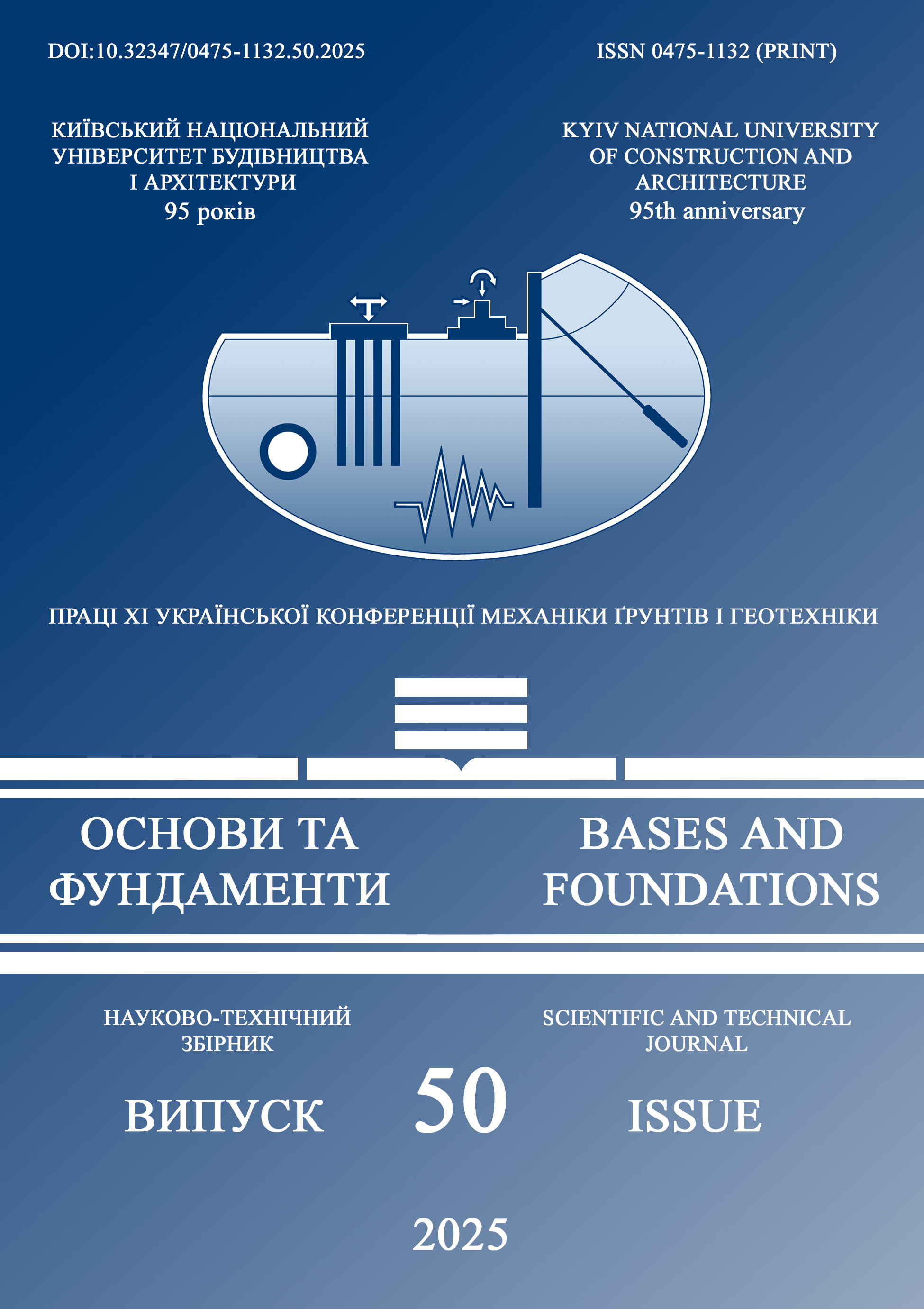Стан гідротехнічних конструкцій гідроелектростанцій Дніпровського каскаду на прикладі Дніпровської ГЕС
Основний зміст сторінки статті
Анотація
В статті розглянуті результати досліджень стану бетону опор автодорожнього переїзду та бетонної водозливної греблі Дніпровської ГЕС, що знаходиться тривалий час (з 1932 року) під впливом природно-кліматичних чинників. Проводилось визначення глибини карбонізації бетону биків з боку верхнього і нижнього б’єфів та у верхній потерні. Оцінка міцності бетону виконувалась із вибурюванням кернів та їх випробуванням в лабораторних умовах.
Важливою задачею гідроенергетики України є забезпечення безпеки та надійності роботи гідротехнічних споруд та охорони навколишнього середовища. Греблі бетонні та залізобетонні – один з найпоширеніших типів гідротехнічних споруд. Вони входять до складу більшості гідровузлів світу. Від їх стану залежить надійна та безпечна робота гідроелектростанцій, вони суттєво впливають на економічну, екологічну та соціальну ситуацію в регіоні їх розташування. Такі греблі будують у різноманітних геологічних умовах. Їх будівництво характеризується високою технологічністю, комплексною механізацією робіт.
Наведені факти щодо підриву двох ГЕС (ДніпроГЕС у 1941 та 1943 роках, Каховської ГЕС у 2023 році та Дніпровської ГЕС1 і ГЕС-2 у 2024 році) та аналіз негативних наслідків злочинного руйнування Каховської ГЕС.
Надійність та безпека гідротехнічних споруд, а також охорона навколишнього природного середовища повинні бути забезпечені в період експлуатації, а також під час ремонту, реконструкції, консервації та їх ліквідації. Будівництво ГЕС Дніпровського каскаду дозволило забезпечити вироблення екологічно чистої пікової електроенергії, що створює сприятливі умови роботи енергосистеми України. Відмічена особливо важлива роль Дніпровського каскаду ГЕС в забезпеченні надійної роботи б’єднаної енергетичної системи України та охорони навколишнього середовища, а також здоров’я людей. Наведені особливості роботи гідротехнічних споруд та дана коротка характеристика споруд Дніпровської ГЕС.
Блок інформації про статтю

Ця робота ліцензується відповідно до Creative Commons Attribution 4.0 International License.
Автори, які публікуються у цьому журналі, погоджуються з наступними умовами: Автори залишають за собою право на авторство своєї роботи та передають журналу право першої публікації цієї роботи на умовах ліцензії Creative Commons Attribution License, котра дозволяє іншим особам вільно розповсюджувати опубліковану роботу з обов'язковим посиланням на авторів оригінальної роботи та першу публікацію роботи у цьому журналі. Автори мають право укладати самостійні додаткові угоди щодо неексклюзивного розповсюдження роботи у тому вигляді, в якому вона була опублікована цим журналом (наприклад, розміщувати роботу в електронному сховищі установи або публікувати у складі монографії), за умови збереження посилання на першу публікацію роботи у цьому журналі. Політика журналу дозволяє і заохочує розміщення авторами в мережі Інтернет (наприклад, у сховищах установ або на особистих веб-сайтах) рукопису роботи, як до подання цього рукопису до редакції, так і під час його редакційного опрацювання, оскільки це сприяє виникненню продуктивної наукової дискусії та позитивно позначається на оперативності та динаміці цитування опублікованої роботи (див. The Effect of Open Access).Посилання
Фаренюк Г. Г., Вайнберг О. І., Хлапук М. М., & Шумінський В. Д. (2019) Надійність та безпека гідротехнічних споруд в умовах тривалої експлуатації. Журнал «Наука та будівництво» № 2 (20). ДП НДІБК, 4-18.
Фаренюк Г. Г., Вайнберг О. І., & Шумінський В. Д. (2020) Надійність та безпека гідротехнічних споруд Дніпровського та Дністровського каскадів ГЕС. Журнал «Наука та будівництво» № 3 (25). ДП НДІБК, 3-12.
Гідротехнічні споруди. Основні положення: ДБН В.2.4-3-2010 (2010). [Чинні від 2011-01-01]. К.: ДП «Укрархбудінформ».
ТСН. (2023). Окупанти підірвали Каховську ГЕС: вода затоплює Херсонщину, які наслідки. https://tsn.ua/ato/rosiyski-okupanti-pidirvali-kahovsku-ges-2344243.html
Радіо свобода. 2023. У 1941 році було підірвано ДніпроГЕС, щоб зупинити німців. Скільки людей загинуло? https://www.radiosvoboda.org/a/pidryv-dniprohes-u-1941-rotsi/31415294.html
Фокус. (2024). "Шукаємо по сусідах": Україна потребує додаткові ЗРК для захисту енергетики https://focus.ua/uk/voennye-novosti/638661-shukayemo-po-susidah-ukrajina-potrebuye-dodatkovi-zrk-dlya-zahistu-energetiki-galushchenko
Настанова щодо обстеження будівель і споруд для визначення та оцінки їх технічного стану: ДСТУ-Н Б В.1.2-18:2016 (2017). – К.: ДП «УкрНДНЦ».
Оцінка технічного стану залізобетонних конструкцій під час експлуатації в агресивних середовищах: СОУ ДП НДІБК В.2.6-02495431-003:2020 (2020) [Чинні від 2020-10-09]. К.: ДП НДІБК.
З.Я. Бліхарський, Р.Ф. Струк & Р.Є. Хміль Дослідження карбонізації бетону в залізо-бетонних конструкціях (2007). Вісник Національного університету «Львівська політехніка» № 600: Теорія і практика будівництва. – 583 с.
Будівельні матеріали. Бетони. Методи визначення міцності за зразками, відібраними з конструкцій: ДСТУ Б В.2.7-223:2009 (2010). – [Чинні від 2010-09-01]. – К.: Мінрегіонбуд.
Будівельні матеріали. Бетони. Методи визначення міцності за контрольними зразками. ДСТУ Б В.2.7-214:2009 (2010). – [Чинні від 2010-09-01]. К.: Мінрегіонбуд, 2010.
Farenyuk G., Vaynberg O., Shuminskyi V. & Khlapuk N. (2019) The reliability and safety of hydraulic engineering structures in conditions of long operation. Journal «Science and construction». № 2 (20). SE NDIBK,
-18 (in Ukrainian)
Farenyuk G., Vaynberg O. & Shuminskyi V. (2020) The reliability and safety of hydraulic engineering structures of the Dnieper and Dniester cascades of hydroelectric power plants. Journal «Science and construction»
№ 3 (25). SE NDIBK, 3-12
Hydraulic structures. Basic principles: DBN V.2.4-3-2010. (2010). [Effective from 2011-01-01]. Kyiv: SE «Ukrarkhbudinform» (in Ukrainian)
TSN. (2023). The occupiers blew up the Kakhovka hydroelectric power station: water is flooding the Kherson region, which is close to us https://tsn.ua/ato/rosiyski-okupanti-pidirvali-kahovsku-ges-2344243.html
Radio Svoboda. 2023. In 1941, the Dnipro Hydroelectric Power Plant was blown up to stop the Germans. How many people died? https://www.radiosvoboda.org/a/pidryv-dniprohes-u-1941-rotsi/31415294.html
Focus. (2024). "Looking for neighbors": Ukraine needs additional air defense systems to protect the energy sector https://focus.ua/uk/voennye-novosti/638661-shukayemo-po-susidah-ukrajina-potrebuye-dodatkovi-zrk-dlya-zahistu-energetiki-galushchenko
Guidelines for the survey of buildings and structures to determine and assess their technical condition: DSTU-N B V.1.2-18:2016 (2017). – K.: SE «UkrNDSC» (in Ukrainian).
Assessment of the technical condition of reinforced concrete structures during operation in aggressive environments: SOU SE NDIBK V.2.6-02495431-003:2020 (2020) [Effective from 2020-10-09]. - K.: SE NDIBK (in Ukrainian).
Z.Y. Blikharsky, R.F. Struk & R.E. Khmil (2007) Research of concrete carbonization in reinforced concrete structures Bulletin of the National University «Lviv Polytechnic» № 600: Theory and practice of construction. – 583.
Building materials. Concrete. Methods for determining strength from samples taken from structures: DSTU B V. 2.7-223:2009 (2010). [effective from 2010-09-01]. K.: Minregionbud (in Ukrainian).
Building materials. Concrete. Methods for determining strength according to control samples: DSTU B V.2.7-214:2009 (2010). [Еffective from 2010-09-01]. K.: Minre-giondud (in Ukrainian).
